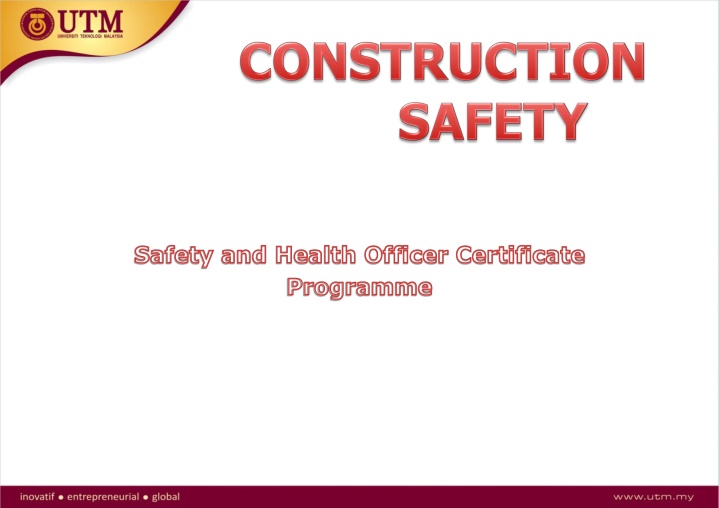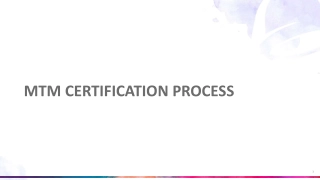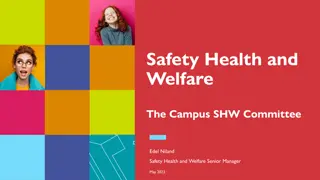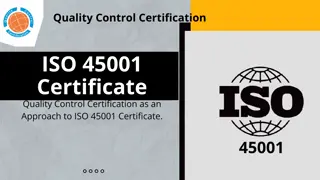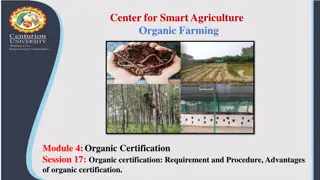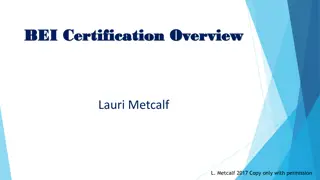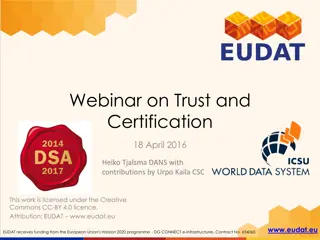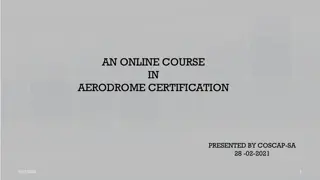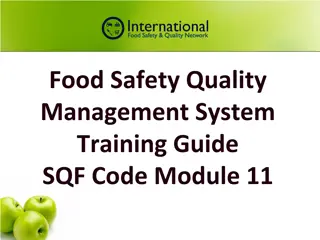Safety and Health Officer Certification Programme
This programme covers essential topics such as standard operating procedures, hazards in construction sites, and employer strategies in safety management. Learn about statutory requirements and safety protocols in building operations according to regulations.
Uploaded on Mar 15, 2025 | 0 Views
Download Presentation

Please find below an Image/Link to download the presentation.
The content on the website is provided AS IS for your information and personal use only. It may not be sold, licensed, or shared on other websites without obtaining consent from the author.If you encounter any issues during the download, it is possible that the publisher has removed the file from their server.
You are allowed to download the files provided on this website for personal or commercial use, subject to the condition that they are used lawfully. All files are the property of their respective owners.
The content on the website is provided AS IS for your information and personal use only. It may not be sold, licensed, or shared on other websites without obtaining consent from the author.
E N D
Presentation Transcript
Safety and Health Officer Certificate Programme
Session/LessonPlans Timing (minutes) 5 5 Learning Objective Main tasks / Process Resources / tools Title Index Standard Operating Procedures for Power Press Machine Contents of the presentation The main purpose of guideline Slide 1 Slide 2 15 Introduction Slide 3, 4and 5 Limitation How to use the guideline 10 Slide 6-15 10 Slide 16 - 25 BREAK (30 MIN) 45 10 10 Slide 26 - 35 Slide 36 - 49 Slide 50 - 48 BREAK (LUNCH) 20 Slide 49 + Video duration (15 min) Slide 50 Slide 51 Slide 52 10 15 30 BREAK (30 MIN) 120 Total Time
OBJECTIVES State the definition of building operations according to the FMA 1967 List at least 6 hazards existent on construction sites Explain the types of accidents at construction sites
OBJECTIVES Elaborate the employer strategy in site safety management Explain the statutory requirements as stated in FMA 1967 and OSH Act 1994
SCOPE Definition and statutory requirements On site activities Machinery commonly used on site Equipments commonly used on site Hazards at construction sites Types of accidents at construction sites Safety and health management Conclusion
DEFINITION AS PER REGULATIONS Factories and Machinery Act 1967 Building Operations: Construction, structural alteration, repair or maintenance of a building (including re-pointing, re- decoration and external cleaning of the structure), the demolition of a building, and the preparation for and the laying of foundation of an intended building
STATUTORY REQUIREMENTS 1) Occupational Safety and Health Act 1994 Responsibility of the Employer Employ a Safety and Health Officer Formulate a Policy and Safe Operating Procedures (SOP) Establish a Safety and Health Committee
STATUTORY REQUIREMENTS Occupational Safety and Health (Safety and Health Officer) Order 1996 Requirement to employ a Safety and Health Officer at the workplace for projects of over RM20 million whether for works of: a) Building operations b) Engineering construction
STATUTORY REQUIREMENTS 2) Factories and Machinery Act 1967 General provisions related to the certification of fitness for machinery, installations and workers Factories and Machinery (Building Operations and Works of Engineering Construction) (Safety) Regulations 1986 Provisions related to the safety and health involving work activities and equipments and workers
ON SITE ACTIVITIES List the activities at the construction site
ON SITE ACTIVITIES Excavation Piling Concrete works Demolition Brick laying Welding works Installation of wires/electric cables and pipes Handling/ transportation of construction materials
ON SITE ACTIVITIES Installation and collapse of scaffolding Form works Painting works Installation and operationalisation of machinery Transportation of raw materials Clearing and cleaning works
MACHINERY/EQUIPMENTS ON SITE MACHINERY/EQUIPMENT Crane (T ower/Crawler) Hoist (Skip hoist) Passenger hoist Gondola Bending machine Cutting machine Excavator Piling and structure APPLICATIONS/USE Lifting material Lifting workers Cutting and shaping piles Cutting metals, wood and plywood Earth excavation Laying columns/building structure Lorry Batching plant Transport construction materials Mixing and delivering cement
MACHINERY/EQUIPMENTS ON SITE Hand tools and mobile power tools - hammer, sledge, drill Stairs Scaffold fixed and mobile Air Compressor Hammer Drill Generator Set Welding equipments
MACHINERY/EQUIPMENTS CERTIFICATE OF FITNESS - DOSH Crane (Tower/Crawler) Passenger hoist Gondola Air compressor Lift Piling and Structure machine Skip Hoist Material Hoist Aerial Platform
HAZARDS ON SITE Heat stress Noise Mineral dust exposure Mechanical hazards Electrical hazards Radiation Chemicals Ergonomic hazards Biological hazards Working at height Confined space Lighting Drowning
CONSTRUCTION SAFETY TYPES OF ACCIDENTS Falling from height Falling at same level Hit by falling object Buried under falling earth /structure Electric shock Drowning Hit by vehicle Inhalation of toxic chemicals Contact with moving machinery Crushed/stuck between objects
FALLING FROM HEIGHT This includes falling from: Stairs Work platforms Roofs or peaks Through floor openings Open sides Scaffolding
FALLING FROM HEIGHT CAUSES OF FALL No fencing of hazardous work area Lack of workplace/equipment maintenance No prior inspection of workplace/equipment Installation of equipment by incompetent persons
FALLING FROM HEIGHT CAUSES OF FALL No provision of safety harness Faulty design of structure / stairs Use of damaged stairs / scaffold Use of unsuitable stairs / scaffold Improper position of stairs / scaffold
FALLING FROM SAME LEVEL Tripping over wires and objects on floor Slips due to slippery floor CAUSES OF FALL: Poor housekeeping Lack of proper housekeeping programme No designated area for storage of equipments
HIT BY FALLING OBJECT CAUSES OF ACCIDENT: Poor housekeeping No toe-board on work platform No overhead protection No installation of safety net Improper lifting techniques
BURIED UNDER FALLING EARTH/STRUCTURE May occur during excavation works, erection of scaffolding and formwork CAUSES OF ACCIDENT: No installation of earth support No guidelines and safe work procedures Overloading Faulty design of structure
BURIED UNDER FALLING EARTH/STRUCTURE CAUSES OF ACCIDENT: Use of unsuitable/damaged scaffolding Position of scaffold is unsuitable No proper maintenance of work area/scaffold No prior inspection of work are/scaffold Erection of scaffold by incompetent persons
ELECTRIC SHOCK CAUSES OF ACCIDENT: Contact with electricity current due to faulty conductor Use of electrical equipments that are damaged or modified No earthling No provision of suitable PPE
DROWNING In confined space tanks, sewerage pipes Lack of oxygen In pools retention pools Swallowing of water CAUSES OF ACCIDENT: Lack of proper ventilation No exhaust system Lack of guidelines and SOPs Presence of excessive water Untrained, unknowledgeable and inexperienced workers
HIT BY VEHICLE CAUSES OF ACCIDENT: No designated passage for pedestrians/workers No guards/fencing to separate vehicle routes No traffic related rules and enforcement in the premises No inspection of vehicles No proper vehicle maintenance Inexperienced and untrained drivers
INHALATION OF TOXIC CHEMICALS IN PAINTING AND WELDING ACTIVITIES CAUSES OF ACCIDENT: Failure to wear proper respiratory protection Insufficient ventilation No exhaust system Untrained and inexperienced workers
CONTACT WITH MOVING OBJECTS CRUSHED IN BETWEEN OBJECTS CAUSES OF ACCIDENT: No guards Use of damaged/faulty guards Lack of training for workers Unsuitable design of guards Guards placed in ineffective positions
SAFETY AND HEALTH MANAGEMENT STRATEGIES: Establish a Safety and Health Committee Identify hazards at the workplace Conduct risk assessment Plan and implement safety and health measures
SAFETY AND HEALTH MANAGEMENT EMPLOYER CONTROL MEASURES: Formulate a Safety and Health Policy Employ a Safety and Health Officer (requirement based on total project value) or site safety supervisor Formulate and enforce safety and health rules at the workplace
SAFETY AND HEALTH MANAGEMENT EMPLOYER CONTROL MEASURES: Establish system for issuance of work permits for high risk activities Increase supervision on high risk activities Provide safety and health induction training for all workers
SAFETY AND HEALTH MANAGEMENT EMPLOYER CONTROL MEASURES: Provide personal protective equipment for all workers and ensure proper use Prepare safe work procedures for all activities Provide suitable and safe equipments for all work activities
SAFETY AND HEALTH MANAGEMENT EMPLOYER CONTROL MEASURES: Select and appoint competent and trained persons for high risk activities such as handling cranes and working at height Investigate all accidents and dangerous occurrences Conduct workplace inspections
SAFETY AND HEALTH MANAGEMENT EMPLOYER CONTROL MEASURES: Provide effective communication system to enable and encourage worker feedback Formulate scheduled preventive maintenance programme for all machinery and equipments Display safety warning signages at appropriate locations
CONCLUSION The various activities at construction sites may produce hazards that may cause accidents There are specific statutory requirements regarding construction safety in the FMA 1967 and OSHA 1994 The employer is responsible for proper safety management to ensure that the protection of worker safety and health as well as to fulfill regulatory requirements
